We’ve all heard about wagyu beef’s legendary marbling and melt-in-your-mouth texture but cooking this premium cut can feel intimidating. The good news? You don’t need to be a professional chef to create restaurant-quality wagyu dishes at home.
This prized Japanese beef deserves cooking methods that honor its exceptional quality and rich flavor profile. From perfectly seared steaks to innovative fusion dishes we’ll explore techniques that maximize wagyu’s natural tenderness while avoiding common mistakes that can ruin this expensive ingredient.
Whether you’re planning a special dinner or want to elevate your culinary skills we’ll guide you through proven wagyu recipes that deliver impressive results every time.
Premium Wagyu Beef Steak With Garlic Butter
We’re showcasing the ultimate wagyu steak preparation that lets the beef’s natural marbling shine through aromatic garlic butter enhancement. This classic combination elevates wagyu’s inherent richness while maintaining the meat’s delicate texture.
Selecting the Perfect Cut
Choose ribeye or strip loin cuts when preparing wagyu steaks with garlic butter. These premium cuts offer the ideal balance of marbling distribution and thickness for even cooking. We recommend selecting steaks between 1 to 1.5 inches thick to ensure proper temperature control throughout the cooking process.
Look for A5 grade wagyu if you want the highest marbling score available. Japanese wagyu typically provides superior fat distribution compared to American wagyu varieties. The abundant marbling in A5 grade creates natural basting during cooking while maintaining incredible tenderness.
Consider portion sizes carefully since wagyu’s richness means smaller servings satisfy more than traditional beef. We suggest 4 to 6 ounce portions per person for optimal enjoyment. Larger portions can overwhelm diners due to wagyu’s intense buttery flavor profile.
Temperature Control for Optimal Results
Bring steaks to room temperature before cooking to ensure even heat distribution throughout the meat. We let wagyu steaks rest for 30 to 45 minutes outside refrigeration before cooking begins. This prevents the exterior from overcooking while the interior remains cold.
Use medium heat settings when searing wagyu steaks to prevent burning the abundant fat content. Cast iron skillets work exceptionally well for maintaining consistent temperatures. We avoid high heat that can cause wagyu’s delicate fat to render too quickly and create smoke.
Monitor internal temperatures precisely using an instant read thermometer for perfect doneness. Target 120°F for rare or 130°F for medium rare to preserve wagyu’s signature texture. The meat continues cooking after removal from heat so we pull steaks 5 degrees before target temperature.
| Doneness Level | Target Temperature | Rest Temperature |
|---|---|---|
| Rare | 115°F | 120°F |
| Medium Rare | 125°F | 130°F |
| Medium | 135°F | 140°F |
Finishing Touches and Presentation
Create compound garlic butter by mixing softened butter with minced fresh garlic and chopped herbs like thyme or rosemary. We prepare this mixture ahead of time so flavors can meld together. The butter should contain 2 cloves of garlic per 4 tablespoons of butter for optimal flavor balance.
Add garlic butter during resting rather than while cooking to prevent burning the garlic solids. We place a generous dollop on each steak immediately after removing from heat. The residual warmth melts the butter while infusing garlic aromatics throughout the meat.
Slice against the grain when serving to maximize tenderness in each bite. We cut wagyu steaks at a 45 degree angle to showcase the beautiful marbling patterns. Arrange slices on warmed plates with the melted garlic butter pooling around the meat for an elegant presentation.
Traditional Japanese Wagyu Sukiyaki

Building on our wagyu expertise, we’ll explore one of Japan’s most beloved communal dishes that transforms premium wagyu into a warm, interactive dining experience. This hot pot style preparation highlights wagyu’s exceptional marbling through gentle simmering in a sweet and savory broth.
Essential Ingredients and Preparation
Wagyu beef selection requires thinly sliced cuts with abundant marbling, typically striploin, chuck roll, or sirloin cuts at 200-350g per 2 servings. We recommend having your butcher slice the wagyu paper thin for optimal cooking results.
Vegetable components include napa cabbage, shiitake mushrooms, green onions, sliced onions, and occasionally tomatoes for added freshness. Each vegetable contributes unique textures and flavors that complement the rich wagyu.
Protein additions feature cubed firm tofu that absorbs the savory broth while providing textural contrast to the tender beef. We suggest cutting tofu into 1-inch cubes for easy handling during cooking.
Noodle options cover glass noodles (shirataki) or chewy udon noodles that soak up the flavorful sauce. Both varieties work excellently, with shirataki offering a lighter option and udon providing more substance.
Warishita sauce preparation combines soy sauce, mirin, sake, sugar, sesame or olive oil, and dashi or beef broth to create the dish’s signature sweet-savory base. This sauce mixture forms the foundation of sukiyaki’s distinctive flavor profile.
Cooking Technique and Timing
Initial broth preparation starts by combining the warishita sauce ingredients and bringing them to a gentle simmer in your sukiyaki pot. We maintain medium-low heat throughout the cooking process to prevent overcooking the delicate wagyu.
Aromatic foundation begins with briefly sautéing garlic and onions in the pot to build flavor layers before adding other ingredients. This step typically takes 2-3 minutes until the aromatics become fragrant.
Wagyu cooking technique involves adding the thinly sliced beef and cooking just until it changes color, preserving the meat’s exceptional tenderness. We recommend cooking wagyu for only 30-60 seconds per side to maintain its buttery texture.
Vegetable integration follows with adding vegetables, tofu, and noodles to simmer for 10-15 minutes until tender but not overcooked. Timing varies based on vegetable density, with harder vegetables like cabbage stems requiring longer cooking than leafy greens.
Continuous cooking method allows for adding fresh ingredients throughout the meal as diners consume portions from the shared pot. This approach keeps the sukiyaki hot and ensures everyone enjoys perfectly cooked components.
Serving Style and Accompaniments
Traditional presentation features the sukiyaki served family style in a shallow pot placed directly on the table, creating an interactive dining atmosphere. We use portable burners or tabletop heating elements to maintain optimal serving temperature.
Customizable portions allow diners to scoop their preferred combinations of wagyu, vegetables, tofu, and noodles into individual bowls. This self-service approach lets everyone tailor their portions to personal preferences.
Raw egg enhancement provides beaten raw egg as a traditional dipping sauce that enriches flavors and creates silky texture when coating the hot ingredients. Quality eggs are essential for this authentic accompaniment.
Seasonal dining experience makes sukiyaki particularly appealing during cooler months when the warm, communal nature of the dish creates cozy gatherings. We find this preparation perfect for intimate dinner parties or family celebrations.
Interactive meal format transforms dinner into an captivating social experience where conversation flows naturally around the shared cooking process. This communal aspect distinguishes sukiyaki from other wagyu preparations and creates lasting memories.
Gourmet Wagyu Beef Tataki

Wagyu beef tataki showcases the art of barely searing premium beef while keeping the center rare and luxurious. This Japanese technique preserves wagyu’s exceptional marbling while creating a beautifully caramelized exterior that enhances both flavor and presentation.
Searing Methods for Perfect Crust
Cast iron skillets deliver the intense heat we need for achieving that perfect tataki crust. We heat our pan until it’s smoking hot before adding the wagyu, ensuring maximum contact between meat and metal for optimal caramelization.
Timing becomes critical when searing each side for exactly 30 to 45 seconds. This brief exposure creates the essential Maillard reaction that develops complex flavors without compromising the rare interior we’re after.
Heavy bottom pans work exceptionally well as alternatives to cast iron. Their superior heat retention maintains consistent temperatures throughout the searing process, preventing hot spots that could overcook portions of our precious wagyu.
Resting the meat immediately after searing allows the juices to redistribute evenly. We typically rest tataki for 2 to 3 minutes before slicing, which ensures every bite delivers maximum tenderness and flavor.
Seasoning and Marinade Options
Dry spice rubs start with our foundation of kosher salt and freshly ground black pepper. These basic seasonings enhance wagyu’s natural flavor without masking its delicate taste profile.
Aromatic additions like coriander, fennel seeds, rosemary, garlic, and smoked paprika bring warmth and complexity to the meat. We apply these spices generously before searing to create flavor layers that complement wagyu’s richness.
Heat enthusiasts can incorporate cayenne pepper or crushed red pepper flakes for a spicy kick. Brown sugar or honey balances these bold flavors with subtle sweetness that pairs beautifully with wagyu’s savory notes.
Balsamic marinades combine acidic elements with oils and seasonings for deeper flavor penetration. Our favorite blend uses balsamic vinegar, olive oil, minced garlic, fresh rosemary, and Dijon mustard for a tangy and earthy profile.
Asian inspired marinades featuring soy sauce, ginger, garlic, and sesame oil enhance umami characteristics. We marinate ribeye steaks for 30 minutes using balsamic vinegar, honey, garlic, soy sauce, salt, and pepper for optimal flavor absorption.
Slicing and Plating Techniques
Thin slicing against the grain maximizes tenderness in every bite of our tataki. We use a sharp knife to create clean cuts that showcase the beautiful contrast between the seared exterior and rare interior.
Artistic arrangement on chilled plates maintains both texture and visual appeal. Cold surfaces prevent the meat from continuing to cook while highlighting the stunning color gradient from crust to center.
Microgreens and finely chopped herbs make excellent garnishes that add freshness without overwhelming the wagyu. Light drizzles of ponzu or citrus soy sauce complement the beef’s richness while providing acidic balance to cut through the marbling.
Presentation timing matters significantly since tataki tastes best when served immediately after slicing. We prepare all garnishes and sauces beforehand to ensure our guests experience the perfect temperature and texture combination.
Luxury Wagyu Beef Carpaccio

We’re taking our wagyu journey from cooked preparations to an elegant raw dish that celebrates the beef’s pure, unadulterated flavor. Wagyu beef carpaccio transforms paper-thin slices of premium beef into a sophisticated appetizer that highlights every nuance of this exceptional meat.
Raw Preparation Safety Guidelines
Safety becomes our top priority when serving wagyu carpaccio since we’re working with raw beef that requires meticulous handling. We always source our wagyu from trusted suppliers who maintain strict quality standards and proper cold chain management throughout distribution.
Chilling our wagyu beef thoroughly before slicing ensures both safety and easier preparation, as the firm texture allows for more precise cuts. We recommend briefly freezing the beef for approximately 30 minutes to achieve those perfect paper-thin slices without tearing the delicate muscle fibers.
Sharp knives make all the difference in carpaccio preparation, as dull blades can tear the meat and create rough surfaces that harbor bacteria. We sanitize our cutting boards and knives before each use, maintaining a clean workspace throughout the entire preparation process.
Temperature control remains critical from start to finish, so we keep the beef well-chilled during slicing and serve immediately after plating. We never leave raw wagyu at room temperature for extended periods, limiting exposure time to maintain both safety and optimal texture.
Flavor Enhancement with Oils and Acids
Balancing wagyu’s rich, buttery texture requires careful selection of complementary oils that enhance rather than mask the beef’s natural characteristics. Extra virgin olive oil provides a smooth foundation that allows the wagyu’s marbling to shine through each bite.
Truffle oil elevates our carpaccio to restaurant-quality sophistication, adding earthy, aromatic depth that pairs beautifully with wagyu’s luxurious profile. We drizzle these oils sparingly, as wagyu’s inherent richness means a little enhancement goes a long way.
Acidic elements cut through the fat content and brighten the overall flavor profile, with fresh lemon juice being our preferred choice for its clean, citrusy notes. We sometimes incorporate light balsamic vinegar for a more complex acid component that adds subtle sweetness alongside the tartness.
Seasoning with truffle salt or high-quality kosher salt amplifies wagyu’s natural flavors without overwhelming the delicate meat. We finish with freshly cracked black pepper to add a gentle heat that complements the beef’s richness perfectly.
Creative Garnish Ideas
Strategic garnishing transforms our wagyu carpaccio from simple sliced beef into an artisanal culinary experience that engages all the senses. Briny capers provide sharp, tangy bursts that create delightful contrast against the smooth, rich wagyu texture.
Fresh arugula adds peppery bite and vibrant green color, creating visual appeal while contributing a crisp texture that balances the soft beef. Shaved Parmigiano-Reggiano introduces nutty, salty notes that enhance wagyu’s umami characteristics without competing for attention.
Finely chopped shallots deliver subtle sharpness and aromatic complexity, while microgreens provide delicate visual elements and fresh flavors. We often incorporate unexpected herbs like fresh basil or fennel seeds to introduce unique aromatic profiles that surprise and delight.
Presentation becomes part of the garnishing process, as we arrange these elements thoughtfully across the carpaccio to create an Instagram-worthy dish that tastes as exceptional as it looks.
Elevated Wagyu Beef Burger
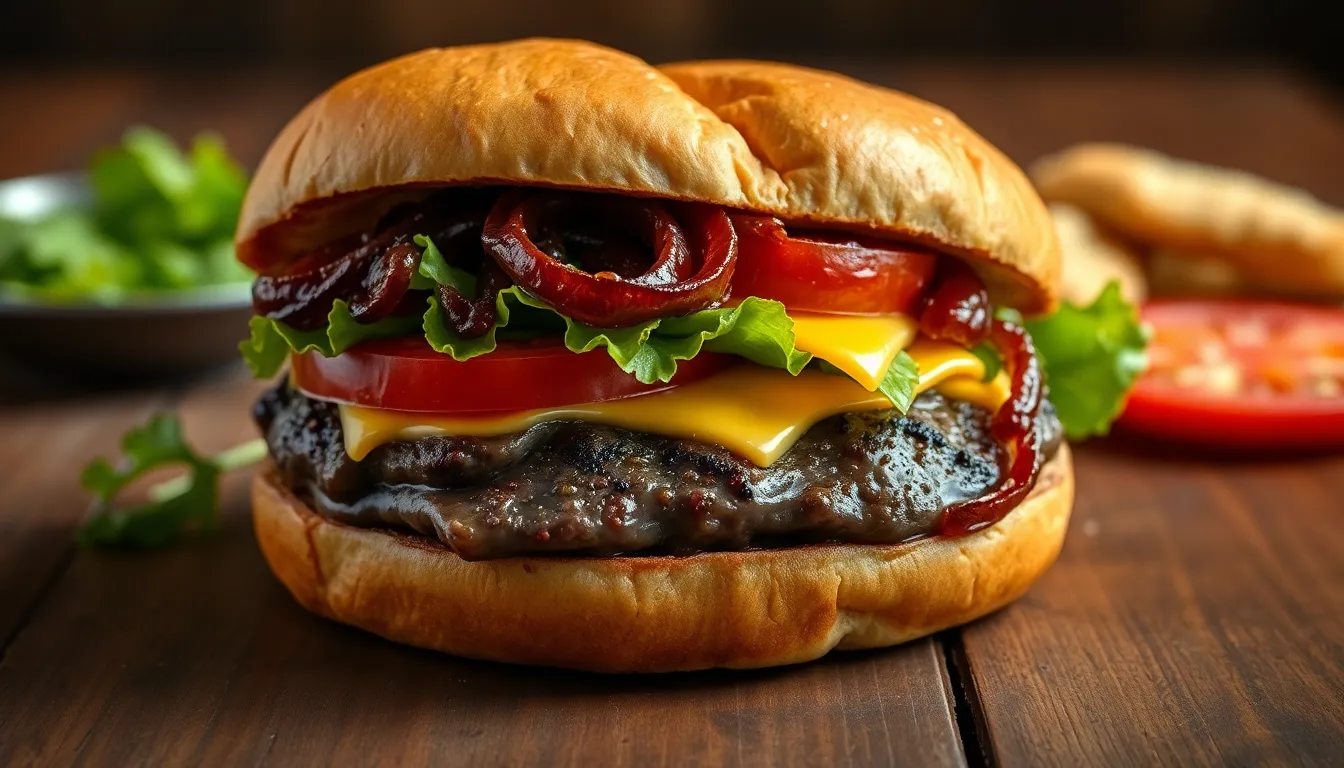
Ground wagyu beef transforms into the ultimate burger experience when we master the art of gentle handling and strategic flavor pairing. Our approach honors the premium nature of this exceptional beef while creating a burger that rivals any fine dining establishment.
Ground Wagyu Handling Tips
Gentle pressure becomes our most important technique when working with ground wagyu beef. We break the meat into medium crumbles first, allowing us to season evenly throughout the mixture with salt and onion powder before forming patties. Minimal handling preserves the delicate texture that makes wagyu so prized.
Forming patties requires a light touch to avoid compacting the meat, which would result in tough, dense burgers. We create a slight indentation in the center of each patty to ensure even cooking across the surface. Temperature control remains crucial as we cook patties on medium heat for about 6 minutes per side, preventing the rich fat from burning.
Resting cooked patties for several minutes before assembly allows juices to redistribute throughout the meat. This simple step ensures every bite delivers the full flavor and tenderness that wagyu beef promises.
Complementary Toppings and Sauces
Cheese selection enhances the rich wagyu flavor without overpowering its natural qualities. Cheddar melts beautifully during the final minutes of cooking, creating a creamy layer that complements the beef’s buttery texture. Fresh vegetables like crisp lettuce and thinly sliced tomatoes provide textural contrast and brightness.
Sauce options range from classic to gourmet, with each adding unique flavor dimensions. Garlic aioli creates a sophisticated base that enhances the meat’s savory notes, while roasted garlic aioli adds deeper complexity. Traditional condiments like mustard, mayo, ketchup, and relish work harmoniously with wagyu’s rich profile.
Red wine caramelized onions represent the pinnacle of gourmet burger toppings. These sweet, deeply flavored onions cook slowly until they develop complex caramelized notes that pair perfectly with wagyu’s buttery richness. Sautéed onions offer a simpler but equally effective option for adding sweetness and depth.
Bun Selection and Assembly
Brioche buns serve as the ideal foundation for wagyu burgers due to their buttery flavor and sturdy yet tender texture. These premium buns complement the richness of wagyu beef while providing enough structure to hold generous patties and toppings. Toasting buns briefly on the grill or skillet adds warmth and prevents sogginess.
Assembly order maximizes flavor distribution and structural integrity throughout each bite. We spread condiments on the bottom bun first, creating a flavorful base that prevents juices from making the bread soggy. Lettuce follows, providing a crisp barrier between the bun and other ingredients.
Layering continues with tomato slices, the wagyu patty, melted cheese, and any additional toppings like caramelized onions. The top bun completes our construction, creating a balanced burger where each component contributes to the overall experience. Proper assembly ensures that every bite contains the perfect ratio of meat, vegetables, and seasonings.
Wagyu Beef Stir-Fry With Asian Vegetables
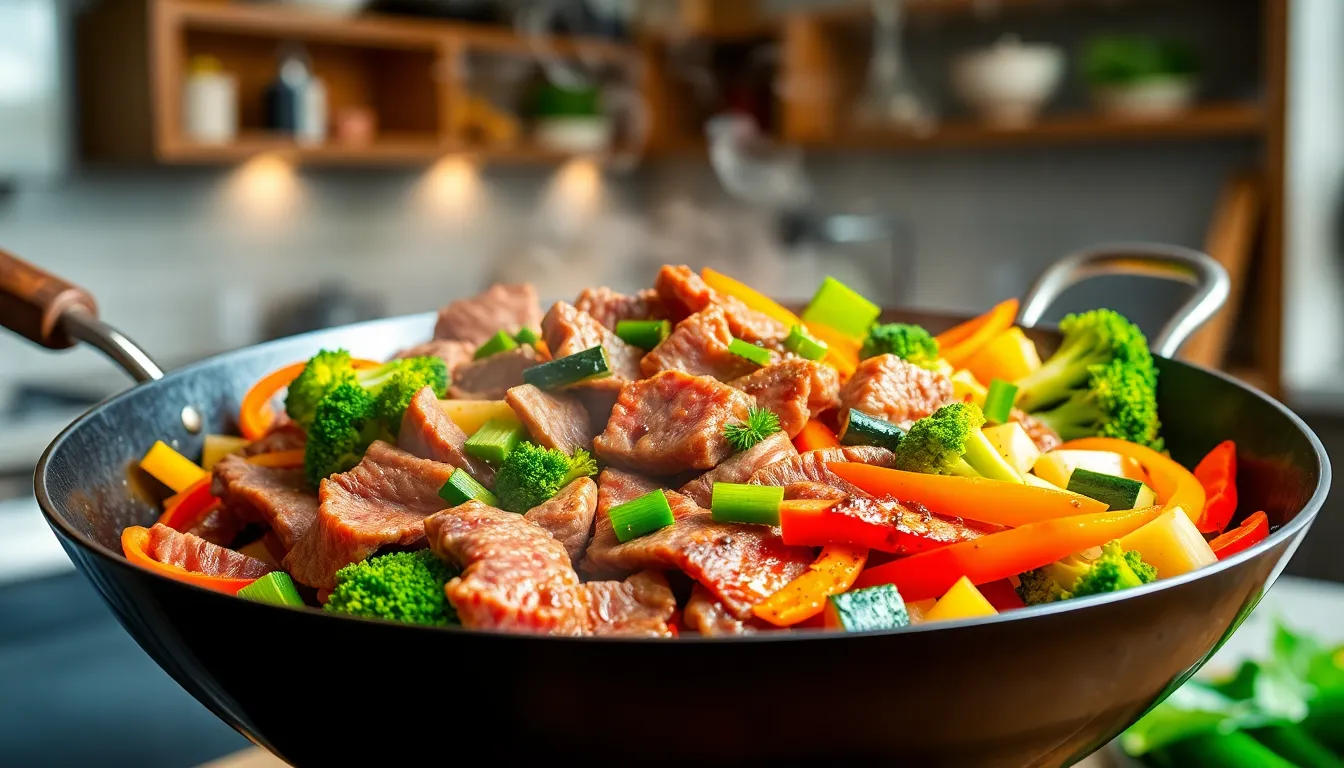
Building on our journey through premium wagyu preparations, we’ll explore how quick stir-frying techniques unlock wagyu’s exceptional marbling while creating vibrant, restaurant-quality dishes at home. This versatile cooking method transforms thinly sliced wagyu into tender morsels that pair beautifully with crisp vegetables and aromatic Asian sauces.
Quick Cooking Techniques
Slicing wagyu thinly against the grain maximizes tenderness and ensures rapid, even cooking throughout each piece. We recommend cutting the beef into strips no thicker than ¼ inch to achieve optimal texture and cooking speed.
High heat stir-frying requires a large pan or wok over medium-high to high heat to quickly sear the beef and vegetables. This technique retains the wagyu’s natural juiciness while keeping vegetables perfectly crisp.
Timing becomes crucial when stir-frying vegetables for 3-5 minutes until tender-crisp, followed by cooking beef just until browned. Overcooking destroys wagyu’s delicate texture and diminishes its rich flavor profile.
Marinating the sliced wagyu for approximately 15 minutes in soy sauce and oyster sauce enhances flavor without masking the beef’s natural taste. Short marination periods work best with premium wagyu cuts.
Sequencing your ingredients properly means adding aromatics like garlic and ginger first, then vegetables, and finally the beef near the end. This method prevents overcooking while building layers of complementary flavors.
Vegetable Pairing Suggestions
Bell peppers in red, yellow, and green varieties provide vibrant color contrast and sweet crunch that complements wagyu’s rich marbling. These peppers maintain their texture during quick stir-frying while adding nutritional value.
Zucchini and squash offer mild flavors that won’t compete with wagyu’s premium taste while contributing satisfying texture to each bite. Julienned carrots provide natural sweetness and visual appeal.
Onions and leeks create aromatic foundations that enhance the overall dish complexity without overpowering the beef’s natural flavors. Their caramelization adds depth to the stir-fry.
Broccoli and snap peas deliver satisfying crunch and fresh green colors that make the dish visually appealing and nutritionally balanced. Sugar snap peas and water chestnuts provide additional textural contrast.
These vegetables complement wagyu’s richness while maintaining their integrity during the high-heat cooking process.
Sauce Combinations and Flavor Profiles
Soy sauce and oyster sauce form the classic base for marinating and finishing wagyu stir-fry, providing essential saltiness and umami depth. This combination enhances wagyu’s natural flavors without masking its premium qualities.
Sesame oil adds toasty, nutty aromas that complement Asian vegetables while creating authentic flavor profiles. A small amount goes a long way in elevating the overall dish.
Garlic and ginger serve as essential aromatics that provide pungency and warmth to balance wagyu’s richness. Fresh versions work better than dried alternatives for maximum flavor impact.
Additional flavor enhancers include honey or miso for sweetness and complexity, rice vinegar for mild acidity, and Chinese five-spice powder for subtle warmth. These ingredients create sophisticated sauce profiles.
A typical stir-fry sauce combines 1 tablespoon each of soy sauce and oyster sauce with sesame oil, fresh garlic, ginger, and a touch of honey for balanced flavor complexity that highlights wagyu’s exceptional qualities.
Slow-Braised Wagyu Short Ribs
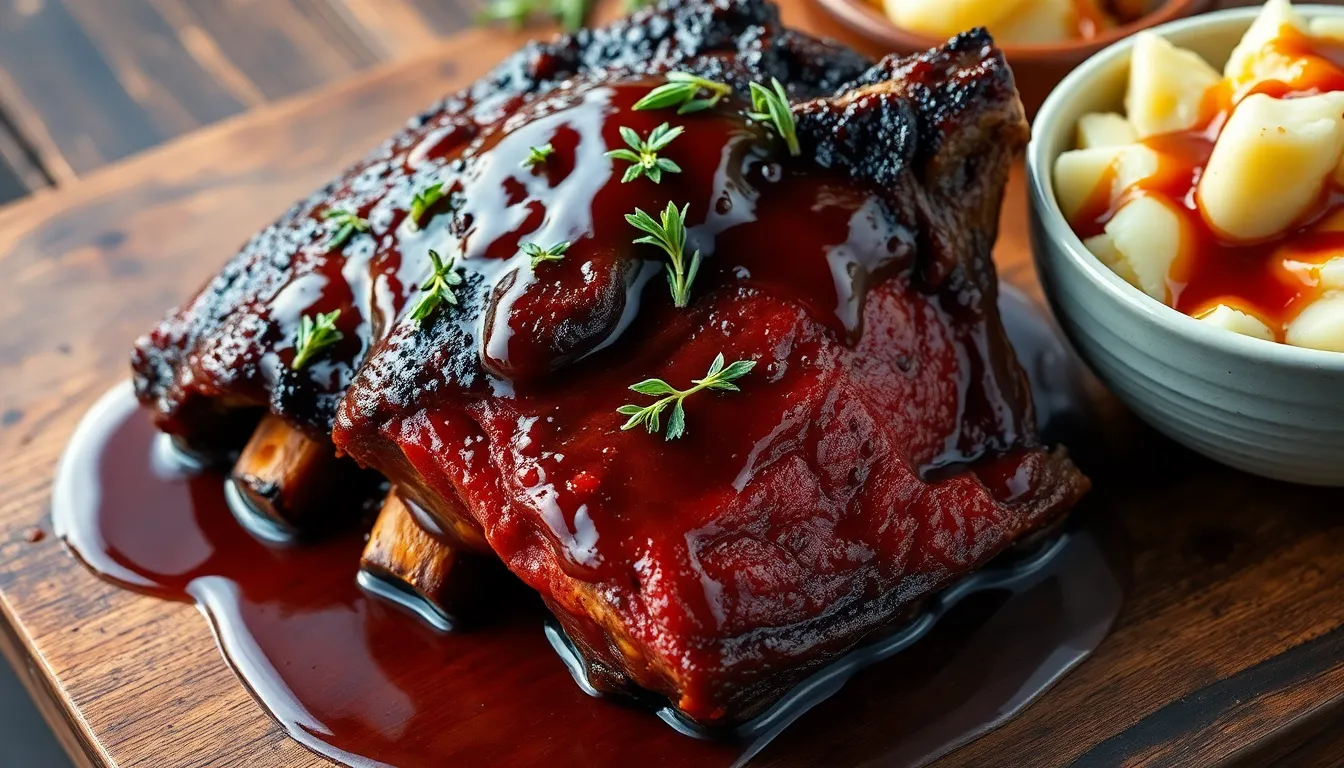
We’re elevating the art of slow cooking with this luxurious take on comfort food that transforms premium wagyu into fall-off-the-bone perfection. This technique harnesses the exceptional marbling of wagyu beef through gentle, prolonged cooking that creates incredibly tender results.
Preparation and Seasoning Methods
Start with boneless wagyu short ribs weighing approximately 2 to 3.7 lbs for optimal portion sizing. Season the ribs generously with salt and pepper on all sides, allowing the seasoning to penetrate the meat’s surface. Coat each piece lightly with all-purpose flour, shaking off excess to create a foundation for both searing and sauce thickening.
Sear the ribs in a large heavy-bottomed pot or Dutch oven with vegetable or olive oil over medium-high heat. Brown each side for about 1 minute until you’ve developed a rich, caramelized crust that locks in flavors. Remove the seared ribs and set them aside while you prepare the braising components.
Braising Liquid Options
Build your braising liquid with red wine as the star component, using 1 to 3 cups depending on your recipe scale for depth and acidity. Add beef broth ranging from 2.5 to 4 cups to keep the meat moist while contributing savory richness throughout the cooking process. Incorporate tomato paste, typically 1 to 2 tablespoons or cups based on your desired intensity, for umami depth and natural sauce thickening.
Create a classic mirepoix base by adding chopped carrots, onions, and celery to complement the wagyu’s richness. Enhance the aromatic profile with fresh herbs like thyme, rosemary, bay leaves, and parsley for complexity. Include minced garlic to round out the flavor foundation and add another layer of savory depth.
Cooking Time and Temperature Guidelines
Return the seared ribs to the pot and cover completely with your prepared braising liquid and aromatics. Bring the mixture to a gentle simmer before covering with a tight-fitting lid to retain moisture and heat.
Cook in an oven preheated to 325°F (160°C) or maintain a gentle simmer on the stovetop for consistent temperature control. Plan for at least 2 hours of cooking time until the ribs become tender and start falling off the bone naturally.
| Cooking Method | Temperature | Time Range | Result |
|---|---|---|---|
| Oven Braising | 325°F (160°C) | 2-4 hours | Fork-tender |
| Stovetop Simmer | Low heat | 2-3 hours | Falling off bone |
| Slow Cooker | Low setting | 4 hours | Maximum tenderness |
Skim off excess fat that rises to the surface during cooking before serving for a cleaner presentation. Serve the finished ribs over mashed potatoes or quinoa, spooning the rich, concentrated braising liquid as a luxurious gravy that complements the tender wagyu perfectly.
Wagyu Beef Sashimi Style
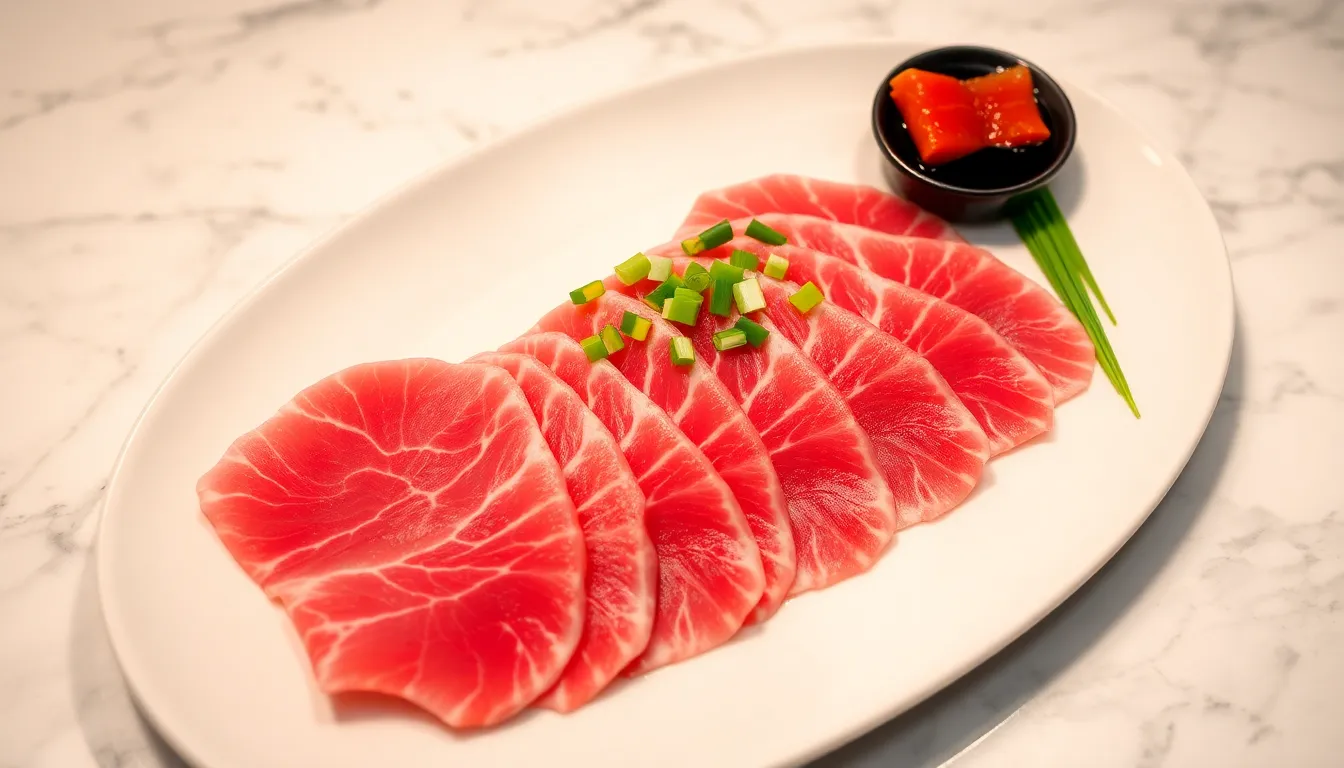
We’re entering the area of raw wagyu preparation where precision and quality standards reach their pinnacle. This Japanese delicacy showcases wagyu’s pure flavor profile without any cooking intervention.
Freshness Requirements and Storage
Wagyu beef for sashimi demands absolute freshness since we’re serving it completely raw. We must source our beef from trusted suppliers who specialize in sashimi grade cuts and maintain impeccable hygiene standards. Temperature control becomes critical as we need to keep the wagyu refrigerated at 32°F (0°C) immediately after purchase.
Storage duration shouldn’t exceed 24 hours from the time we slice the beef to ensure both safety and optimal texture. Vacuum sealing can extend freshness marginally, but we recommend consuming wagyu sashimi as quickly as possible after cutting. Our investment in premium wagyu deserves this level of attention to freshness standards.
Cutting Techniques for Presentation
Slicing wagyu sashimi requires exceptional knife skills and the right equipment to highlight the beef’s legendary marbling. We need a sharp sashimi grade knife to achieve paper thin slices that practically melt on the tongue. Cutting against the grain becomes essential for maximizing tenderness and creating the perfect mouthfeel experience.
Presentation techniques can transform our slices into visual masterpieces by arranging them in fan patterns or elegant folds on chilled plates. Maintaining cold temperatures throughout the cutting and plating process preserves the wagyu’s texture and prevents any unwanted warming. Each slice should showcase the intricate marbling that makes wagyu so prized among beef connoisseurs.
Traditional Japanese Accompaniments
Traditional accompaniments for wagyu sashimi focus on subtle enhancement rather than overpowering the beef’s natural richness. We typically serve light soy sauce or ponzu (a citrus soy based sauce) for delicate dipping that complements without masking the wagyu’s flavor profile. Wasabi provides a clean, pungent kick that cuts through the beef’s buttery richness and cleanses the palate between bites.
Pickled ginger offers palate cleansing properties while finely sliced scallions add a gentle onion note that pairs beautifully with raw beef. Some preparations include a small dollop of horseradish, particularly when we lightly sear the wagyu surface for textural contrast in sushi style presentations. These accompaniments honor Japanese tradition by maintaining the delicate balance that allows wagyu’s exceptional qualities to shine through each carefully crafted bite.
Pan-Seared Wagyu With Wine Reduction
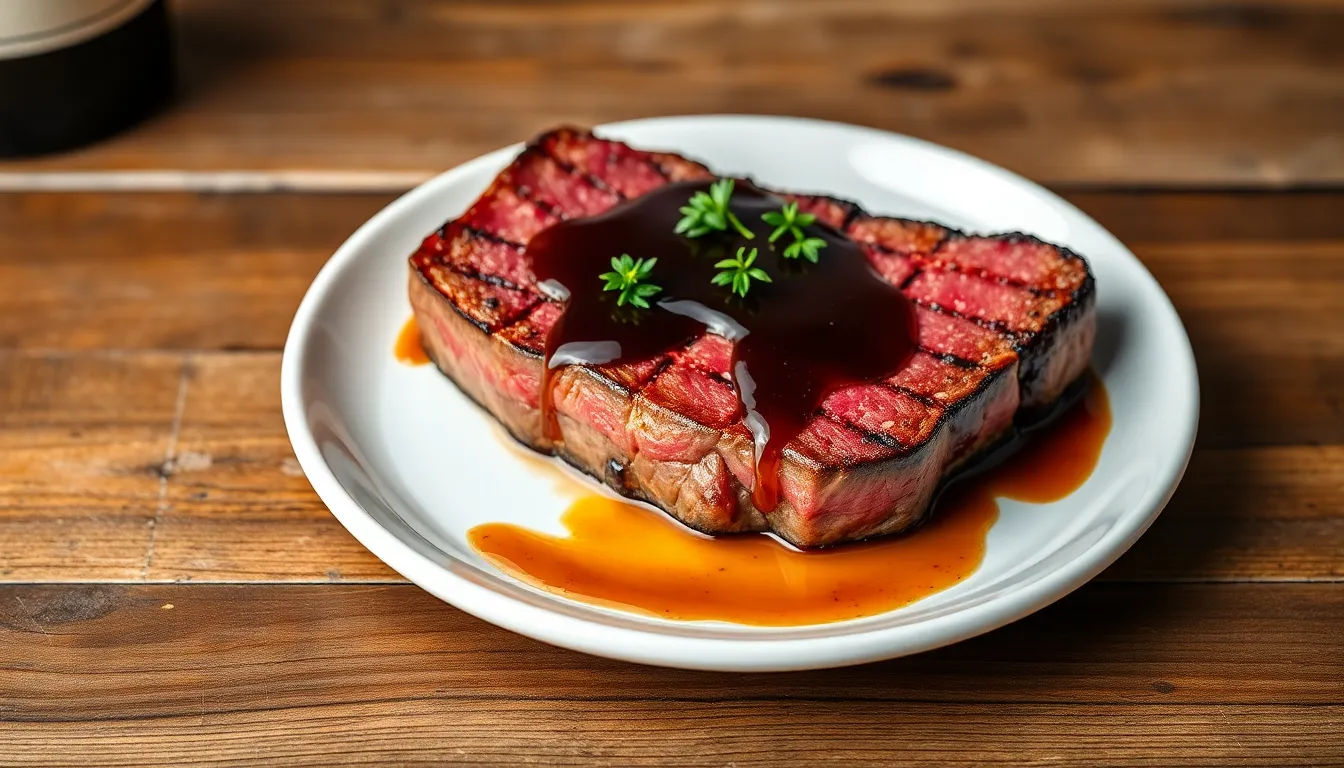
Pan seared wagyu with wine reduction creates an elegant restaurant quality dish that showcases the beef’s natural marbling while adding sophisticated depth through a rich sauce. This technique transforms premium wagyu into a luxurious dining experience perfect for special occasions.
Pan Selection and Heat Management
Cast iron skillets provide the ideal foundation for searing wagyu beef due to their superior heat retention and even distribution properties. We recommend preheating your cast iron pan over medium high to high heat until it reaches the smoking point for optimal crust development. Lightly grease the pan with butter, olive oil, or rendered wagyu fat from trimming to enhance flavor and prevent sticking.
Temperature control becomes critical when working with wagyu’s high fat content and extensive marbling. Medium high heat allows us to achieve a perfect sear without burning the delicate marbled fat that makes wagyu so special. The pan’s surface should be hot enough to create an immediate sizzle when the beef touches it.
Wine Pairing for Reduction Sauce
Full bodied red wines complement wagyu’s rich, buttery flavor profile while creating depth in the reduction sauce. Cabernet Sauvignon offers robust tannins and dark fruit notes that pair exceptionally well with the marbled beef. Merlot provides a smoother alternative with its softer tannins and plush texture that enhances the overall dining experience.
Malbec serves as another excellent choice for both the reduction sauce and wine pairing, delivering bold flavors that stand up to wagyu’s intensity. These wines contain enough structure and complexity to create a reduction sauce that enhances rather than overwhelms the beef’s natural characteristics. The same wine used in the reduction can be served alongside the finished dish for perfect harmony.
Timing for Perfect Doneness
Wagyu cooks significantly faster than conventional beef due to its exceptional fat content and marbling structure. Thick cuts require approximately 3 to 4 minutes per side to achieve rare to medium rare doneness while preserving the beef’s signature tenderness. Thinner steaks need only 45 seconds to 1 minute per side for rare preparation.
Internal temperature monitoring ensures precise doneness without overcooking this premium beef. We target 125°F to 130°F for medium rare, which preserves wagyu’s juiciness and showcases its unique texture. After searing, the steak should rest covered loosely with foil for 5 to 6 minutes to allow juices to redistribute throughout the meat.
Wine reduction sauce preparation begins while the steak rests, utilizing the same pan to capture all the flavorful browned bits. Deglaze with your chosen red wine, scraping up the caramelized fond, then reduce over medium heat until the sauce thickens slightly for the perfect finishing touch.
Grilled Wagyu Skewers With Vegetables
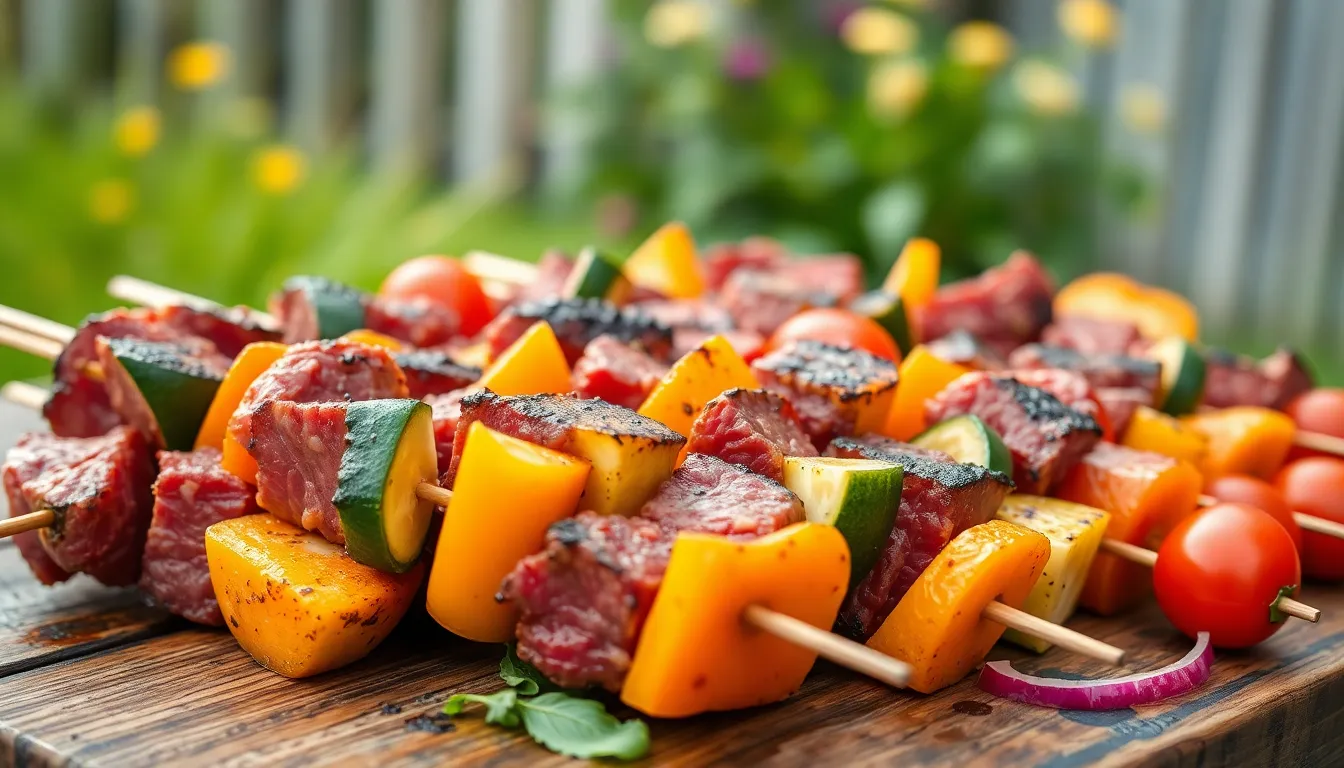
These elegant skewers combine wagyu’s exceptional marbling with fresh vegetables for an impressive outdoor dining experience. We’ll show you how to preserve the beef’s delicate flavor while creating perfectly balanced bites.
Marination Techniques
Salt your wagyu pieces at least 40 minutes before grilling to enhance their natural flavor without overpowering the meat’s delicate taste profile. Simple marinades work best with wagyu’s rich marbling, so we recommend combining mild ingredients like soy sauce, minced garlic, and a touch of mirin or sugar. These gentle seasonings complement the beef’s inherent richness while allowing its premium quality to shine through.
Light seasoning preserves wagyu’s distinctive texture and prevents the marinade from masking the meat’s natural characteristics. Apply the marinade sparingly, using just enough to coat each piece before threading onto skewers. This minimal approach ensures your wagyu maintains its luxurious mouthfeel and signature flavor profile.
Grilling Temperature and Duration
Dual zone grilling provides the ideal setup for wagyu skewers, giving you precise control over temperature and cooking time. Start with high direct heat around 600°F for initial searing, then move skewers to indirect heat between 350°F and 425°F to finish cooking gently.
Sear wagyu pieces quickly on direct heat to develop a beautiful crust, typically taking about 5 minutes for the first side. Move skewers to the cooler zone after turning, allowing 3 to 4 minutes for rare to medium rare doneness. Target internal temperatures of 120°F to 125°F for rare or 130°F to 135°F for medium rare to preserve the meat’s tenderness and fat integrity.
Temperature control prevents burning wagyu’s delicate fat while ensuring even cooking throughout each piece. Monitor your grill carefully during this process, as wagyu cooks faster than conventional beef due to its exceptional marbling.
Vegetable Selection and Preparation
Choose vegetables that complement rather than compete with wagyu’s rich flavor profile. Bell peppers, zucchini, mushrooms, cherry tomatoes, and red onions work exceptionally well on skewers alongside premium beef. Cut all vegetables into bite sized pieces to ensure even cooking and easy eating.
Light oil and simple seasoning prevent vegetables from sticking while maintaining the skewer’s flavor balance. Brush vegetables lightly with neutral oil and season with salt and pepper before threading onto skewers with your wagyu pieces. This preparation method allows each ingredient to cook evenly without overwhelming the beef’s delicate taste.
Arrange vegetables and wagyu alternately on skewers to create visual appeal while ensuring proper heat distribution during grilling. This strategic placement helps vegetables cook at the same rate as your premium beef, creating perfectly balanced bites every time.
Conclusion
Mastering wagyu beef recipes opens up a industry of culinary possibilities that’ll transform your home cooking forever. Whether you’re searing a perfect steak or preparing delicate sashimi these techniques ensure you’re making the most of this premium ingredient.
We’ve shown you that cooking wagyu doesn’t require professional training – just the right knowledge and respect for the beef’s exceptional qualities. From quick stir-fries to slow-braised short ribs each method highlights wagyu’s unique marbling and flavor profile.
The key to success lies in understanding temperature control proper handling and letting wagyu’s natural richness shine through. With these proven recipes and techniques you’re ready to create restaurant-quality dishes that’ll impress family and friends while elevating your culinary skills to new heights.
Frequently Asked Questions
What makes wagyu beef different from regular beef?
Wagyu beef is renowned for its exceptional marbling, which creates a tender, buttery texture and rich flavor. The intricate fat distribution throughout the meat results in superior taste and melt-in-your-mouth quality that sets it apart from conventional beef cuts.
Do I need professional chef skills to cook wagyu at home?
No, you don’t need professional training to cook wagyu successfully. With proper techniques, temperature control, and quality ingredients, home cooks can create restaurant-quality wagyu dishes. The key is understanding how to enhance wagyu’s natural tenderness and flavor.
What’s the best wagyu cut for steak preparation?
Ribeye and strip loin cuts are ideal for steak preparation, with A5 grade wagyu offering the best marbling and flavor. These cuts showcase wagyu’s exceptional quality while being forgiving for home cooking methods.
How should I prepare wagyu for cooking?
Always bring wagyu to room temperature before cooking. This ensures even cooking throughout the meat. Handle the beef gently to preserve its delicate texture, and avoid over-seasoning to let the natural flavors shine.
What’s the ideal cooking temperature for wagyu steak?
Cook wagyu over medium heat to prevent burning the fat. Use a meat thermometer to monitor internal temperature, aiming for 120-125°F for rare or 130-135°F for medium-rare to preserve the beef’s exceptional tenderness.
Can wagyu be eaten raw?
Yes, high-quality sashimi-grade wagyu can be eaten raw in preparations like carpaccio, sashimi, or tataki. Ensure you source from trusted suppliers and maintain strict hygiene and temperature control when handling raw wagyu.
What vegetables pair well with wagyu?
Asian vegetables like bok choy, shiitake mushrooms, and snap peas complement wagyu’s richness in stir-fries. For Western preparations, caramelized onions, roasted root vegetables, and fresh arugula provide excellent flavor balance.
How thin should I slice wagyu for different preparations?
For carpaccio and sashimi, slice paper-thin using a sharp knife. For stir-fries, cut against the grain into thin strips. For tataki, slice into 1/4-inch pieces against the grain to maximize tenderness.
What’s the best way to make wagyu burgers?
Handle ground wagyu gently, breaking it into medium crumbles for even seasoning. Form patties with minimal handling and cook over medium heat. Let the patties rest after cooking to ensure optimal flavor and tenderness.
How do I make wagyu sukiyaki at home?
Use thinly sliced wagyu cuts and prepare warishita sauce with soy sauce, mirin, and sugar. Gently simmer ingredients in sequence, starting with the sauce base, then adding wagyu and vegetables with specific timing for optimal texture.







